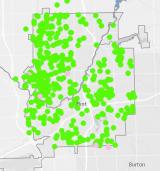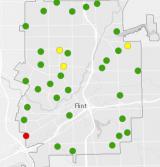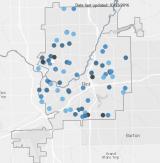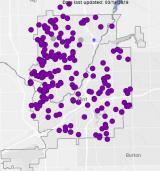Flint Water Sampling Objectives
EPA completed five sampling objectives to test different aspects of Flint's drinking water. Each effort involved collecting samples at locations throughout the city and submitting them for analysis in an EPA laboratory.
EPA continues to monitor chlorine on a biweekly basis and collect sequential samples for lead assessment on a bimonthly basis.
Flint Water Quality Sampling FAQs
Quality Assurance Project Plan (QAPP)
1) Chlorine Residual Monitoring
EPA is collecting samples at businesses and homes throughout Flint to determine chlorine levels in the drinking water system. Chlorine is used to disinfect drinking water and prevent the growth of viruses and bacteria such as E. coli. At appropriate levels, the presence of chlorine in drinking water is normal. At monitoring locations where chlorine is not found, EPA follows up with testing for microbial contamination.
Interactive Map of EPA Chlorine Sampling Results
Summary of results (January 23, 2016 - November 15, 2016: Chlorine Residual Monitoring Rounds 1 - 5(1 pg, 284 K)
2) Recurring Chlorine Monitoring
Chlorine residual levels are being measured by EPA at 24 locations distributed around the City of Flint. Ten additional locations are being sampled by the Flint water department. The results measured indicate whether there is enough chlorine throughout the City of Flint drinking water system to maintain a barrier to prevent the growth of viruses and bacteria such as E. coli. The results may indicate the need to boost chlorine dosage or flush pipes in certain areas in the system. These data provide information for any necessary actions to be taken by the City of Flint water department.
Additionally, EPA is sampling these locations for the following disinfection byproducts (DBPs):
-
Total trihalomethanes
-
Chloroform
-
Dichlorobromomethane
-
Dibromochloromethane
-
Bromoform
-
Monochloroacetic Acid
-
Trichloroacetic Acid
-
Dichloroacetic Acid
-
Monobromoacetic Acid
-
Dibromoacetic Acid
-
Bromochloroacetic Acid
-
Bromodichloroacetic Acid
-
Chlorodibromoacetic Acid
-
Tribromoacetic Acid
Interactive Map of EPA Recurring Chlorine Monitoring Results (Chlorine only)
Summary of results (March - June 2016): DBP Data from Recurring Monitoring Sites(1 pg, 40 K)
Sequential Sampling for Lead Assessment
EPA is sampling for lead in drinking water in Flint homes. At each location, a sequential series of 15-20 water samples is collected, each representing a length of pipe from the home to the water main. This type of sampling looks at different plumbing materials to evaluate sources of lead in drinking water. Sequential samples are collected every two months at select homes to determine whether or not corrosion control is working throughout the water system.
Interactive Map of EPA Lead Assessment Results (Round 1)
Interactive Map of EPA Lead Assessment Results (Round 2)
Interactive Map of EPA Lead Assessment Results (Round 3)
Interactive Map of EPA Lead Assessment Results (Round 4)
Interactive Map of EPA Lead Assessment Results (Round 5)
Summary of Round 1 Results (January 28, 2016 - March 21, 2016): Sequential Data (Round 1)(1 pg, 2 MB)
Summary of Round 2 Results (May 3, 2016 - May 16, 2016): Sequential Data (Round 2)(1 pg, 2 MB)
Summary of Round 3 Results (July 12, 2016 - July 22, 2016): Sequential Data (Round 3)(1 pg, 1 MB)
Summary of Round 4 Results (September 1, 2016 - September 24, 2016): Sequential Data (Round 4)(1 pg, 1 MB)
Summary of Round 5 Results (October 26, 2016 - November 15, 2016): Sequential Data (Round 5)(1 pg, 1 MB)
Testing In-Home Lead Filters
NSF-certified lead removal filters are being distributed in Flint by the State of Michigan to remove lead from household water and make it safe for people to drink. EPA sampled drinking water in households to test the effectiveness of these filters at removing lead at high concentrations. EPA sampling results show that lead-removal filters are working as expected in Flint homes. EPA continues to recommend that Flint residents use NSF-certified filters in their homes.
Water samples were analyzed for:
- Lead
- Copper
- Zinc
- Aluminum
- Iron
- Calcium
- Cadmium
- Potassium
- Magnesium
- Manganese
- Sodium
- Nickel
- Chromium
- Tin
- Chlorine *
- pH *
* Data available under Chlorine tab
Interactive Map of EPA Filter Evaluation Results
Summary of results (Jan. 30, 2016 - May 6, 2016): Filter Evaluation (1 pg, 2 MB)
Hot/Cold Water Sampling
EPA collected cold and hot water samples to compare metals in the cold water lines and the hot water tank. Cold water samples were collected immediately from the tap, while hot water samples were collected after the water ran until it was hot.
Water samples were analyzed for:
- Aluminum
- Cadmium
- Calcium
- Chromium
- Copper
- Iron
- Lead
- Magnesium
- Nickel
- Potassium
- Sodium
- Zinc
- Chlorine
- pH
Summary of results (March 14, 2016 - April 2, 2016): Hot/Cold Water(1 pg, 205 K)
Technical Assistance Sampling
EPA collected water samples from homes participating in a study being conducted by health agencies. Water samples were collected from kitchen and bathroom fixtures at different temperatures and analyzed for metals and anions. At select homes, water samples were collected at different temperatures and analyzed for additional organic compounds, including disinfection byproducts (DBPs).
Water quality data was provided to health agencies for evaluation and communication with residents. Health agencies will provide data to residents. Once all residents receive their results, EPA will post a spreadsheet of data.
Water samples were analyzed for:
- 24 Metals
- Calcium
- Cadmium
- Potassium
- Magnesium
- Manganese
- Sodium
- Nickel
- Chromium
- Tin
- Antimony
- Arsenic
- Barium
- Beryllium
- Boron
- Molybdenum
- Selenium
- Silver
- Thallium
- Vanadium
- Disinfection Byproducts (DPBs)
- Trihalomethanes
- Chloroform
- Bromodichloromethane
- Bromoform
- Dibromochloromethane
- Haloacetonitriles
- Bromochloroacetonitrile
- Dibromoacetonitrile
- Dichloroacetonitrile
- Trichloroacetonitrile
- Other DBPs Chloral Hydrate
- Chloropicrin
- 1,1-Dichloro-2-propanone
- 1,1,1-Trichloro-2-propanone
- Carbon Tetrachloride
- 1,2-Dibromo-3-chloropropane [DBCP]
- 1,2-Dibromoethane [EDB]
- Tetrachloroethylene
- 1,1,1-Trichloroethane
- 1,1,2-Trichloroethane
- Trichloroethylene
- 1,2,3-Trichloropropane
- Bromochloroacetic acid (BCAA)
- Bromodichloroacetic acid (BDCAA)
- Chlorodibromoacetic acid (CDBAA)
- Dalapon Dibromoacetic acid (DBAA)
- Dichloroacetic acid (DCAA)
- Monobromoacetic acid (MBAA)
- Monochloroacetic acid (MCAA)
- Tribromoacetic acid (TBAA)
- Trichloroacetic acid (TCAA)
- Chloride
- Fluoride
- Sulfate
- Chlorine
- pH




